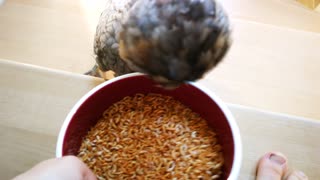Premium Only Content

Trained Seal Catches Rings Around Its Neck
Have you ever seen a seal playing? It is proven that seals are one of the most intelligent animals in the ocean, as they are animals capable of understanding people's behavior and following their instructions, so it is very common to find seals in marine parks and zoos, since these animals They can be very polite and affectionate with the people around them. In addition to being polite, seals can also be very playful, as they like to play with their owners or trainers, seals love to play with rings and balls, so in this case we see how this little seal plays, catch the rings with their trainers. This little seal is adorable!
The seals are adapted to live in the sea. Like other marine mammals such as whales and dolphins, they can dive into the bottom for long periods of time in search of prey, their bodies are optimized to move efficiently in the water and have fat to protect them from the cold. But unlike whales and dolphins, seals spend some time outside the sea. They stop on land (their young would drown if they did otherwise) and change their skin every year on land. Seals can also move on land properly, although not very elegantly.
Most mammals need to maintain a body temperature. The sea is much colder than this and expels heat from a hot body much faster than air. Seals have treated this in several ways. They have a hairy layer that catches the air and uses it as an additional insulating layer. However, when a seal is submerged, the pressure forces the air out of the skin, so this only works when the seal is on the ground or near the surface. Much more important is the layer of fatty tissue under the skin, called fat.
Sometimes the seals are so well insulated from the cold that they overheat. Seals observers occasionally see seals shaking their fins in the air when they leave the ground. This is not a movement of inactivity. The fins have a large supply of peripheral blood that allows heat to escape. The movement of the waves increases heat loss and, therefore, cools the animal. The intelligent inventiveness of the seal often finds other ways to stay cool, looking for the shadow of a rock or a cliff or lying in a puddle of water.
It is a pity that most people only see the seals go awkwardly to the shore. There are moments that compare with the grace and speed of swimming a seal. Whether alone or in a group, the movements of a seal in its true surroundings are like an underwater ballet. You can swim at a speed of 20 knots when you chase your prey, although most of the time you sail less than that. Gray and common seals feed on a variety of prey: fish, shellfish, squid and octopus. They are opportunistic diners, and they will eat whatever is available, including cod, herring, flounder, scorpion, salmon, mackerel, lanzón, shrimp and cucumbers. Their fish diet often puts them in conflict with Scottish fishermen.
-
 0:57
0:57
ViralHog
6 years ago $13.09 earnedDeer Walks Around With Broken Neck
16.5K -
 0:20
0:20
ViralHog
6 years ago $0.14 earnedWoman Catches Angry Kookaburras
485 -
 0:41
0:41
ViralHog
6 years ago $1.51 earnedWheeled Tortoise Gets Around
3.72K2 -
 0:30
0:30
ViralHog
6 years ago $0.44 earnedFederike the Fully Trained Chicken
2.24K1 -
 0:05
0:05
SubwayCreatures
6 years agoPigeon walks around subway train
5661 -
 0:10
0:10
SubwayCreatures
6 years agoRat scurries around subway station platform
77 -
 0:24
0:24
SubwayCreatures
6 years agoPigeon walking around inside subway train
1.76K2 -
 0:09
0:09
SubwayCreatures
7 years agoPigeon walking around inside empty train
8461 -
 1:13
1:13
cdngreenwaterdiver
6 years ago $1.25 earnedHerd of deer join family around backyard campfire
12.9K1 -
 0:55
0:55
ViralHog
6 years ago $0.08 earnedFox Plays Around in Garden
45